

A Pandemic-Proof Approach to Teaching. Digital Promise. Fall 2020 – Planning a Successful Restart. 1 to 3 p.m.

ET | Discussion Rooms Open Discussion 1 Kick Start for Fall: 5 Principles for Instructional Leaders The impact sudden school closures will have on academic growth remains to be seen. Some kids may see a boost from personalized, high-quality learning experiences at home, while students who did not have consistent support or instruction may slide. How to Create a Virtual Bitmoji Classroom in Google Slides or PowerPoint — Hello, Teacher Lady. If you want to create a Google Meet or Agenda slide like mine (or something similar), you can keep the default page dimensions and move onto Step 2.
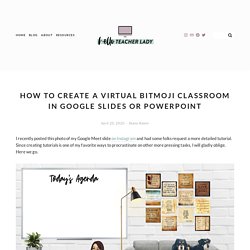
If you want to create a Google Classroom header, change the page dimensions to 1,000 x 250 pixels by going to File —> Page Setup in Google Slides or Design —> Page Setup in PowerPoint. Just a warning though: When you upload your banner on Google Classroom, you’ll get this frustrating dark overlay on your image. It’s an accessibility thing and can’t be changed, so just keep that in mind and try to keep everything as bright as possible.
To create a custom Google homepage, you’ll want the dimensions somewhere in the neighborhood of 15 in x 8 in. The Difference Between Emergency Remote Teaching and Online Learning. Well-planned online learning experiences are meaningfully different from courses offered online in response to a crisis or disaster.

Colleges and universities working to maintain instruction during the COVID-19 pandemic should understand those differences when evaluating this emergency remote teaching. Due to the threat of COVID-19, colleges and universities are facing decisions about how to continue teaching and learning while keeping their faculty, staff, and students safe from a public health emergency that is moving fast and not well understood.
Virtual Education Dilemma: Scheduled Classroom Instruction vs. Anytime Learning. With schools shut down across America, K-12 teachers faced with a question many likely thought they'd never have to ask: When and how often during the school day do my students need to see me?
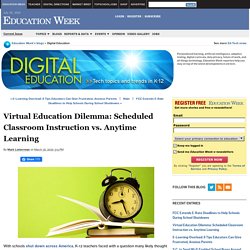
Distance education can be broken down into two broad approaches: synchronous and asynchronous. The former consists of the teacher offering a lesson to the class of students at the same time; the latter provides the student with tools to complete the work on their own time, and direct involvement from the teacher can happen anytime. (For more details, check out this guide from Wisconsin educators, such as Diane Doersch, the technical project director for Digital Promise and a former chief technology officer in public schools. And read this guide from Educause about research on the two different approaches.) Designing for Online Learning. Registration closes at 7pm ET on June 18.
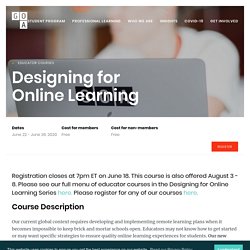
This course is also offered August 3 - 8. Please see our full menu of educator courses in the Designing for Online Learning Series here. Please register for any of our courses here. About - Triple E Framework. Idea Paper 42. 5 Must-Have Elements for Every Online Class. When 2013 Online Teacher of Year Renee Citlau moved to the classroom after previous careers in business and accounting, she was alarmed by what she encountered: Too many students were not engaged in their own educations; some struggled with even the most basic language skills.
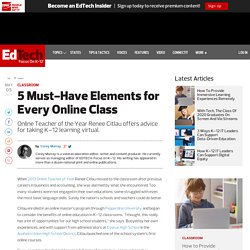
Surely the nation’s schools and teachers could do better. Citlau enrolled in an online master’s program through Pepperdine University and began to consider the benefits of online education in K–12 classrooms. “I thought, this really has a lot of opportunities for our high school students,” she says. Buoyed by her own experiences, and with support from administrators at Cyprus High School in the Anaheim Union High School District, Citlau launched one of the school system’s first online courses. Five years later, the district boasts a full slate of curriculum-approved, teacher-generated online courses, with 23 optional classes scheduled for the 2013–2014 school year. How to Foster a Positive School Climate in a Virtual World. As COVID-19 upended schools across the country, leaders and teachers transitioned to a remote learning environment with unprecedented speed and managed an array of tactical issues.
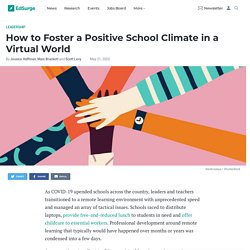
Schools raced to distribute laptops, provide free-and-reduced lunch to students in need and offer childcare to essential workers. Professional development around remote learning that typically would have happened over months or years was condensed into a few days. As we continue to adjust to this new virtual learning environment, success will depend, to a large extent, on whether we can shift our focus from tactical to strategic. 7 guidelines for effective teaching online. Inside Digital Learning asked four authors of books about online education for their expert advice on how instructors and their institutions can excel in virtual course instruction. The authors agreed that the online classroom is different enough from the traditional one that faculty members and adjuncts need to create courses for digital delivery that are substantially different from those they teach on campus.
And they said teaching online requires an even keener focus on student engagement than the face-to-face model does. “Years ago, we used to say the danger of online courses was they were just going to become electronic correspondence courses,” said Rita-Marie Conrad, who along with Judith V. Boettcher, wrote The Online Teaching Survival Guide. A School on the Rise Sees Progress Halted by the Pandemic - MindShift. Early signs were promising.

In Beber’s first year, 2018-19, the school’s rating improved to a C, and teachers and staff reported that student behavior and teacher morale improved too. But the coronavirus pandemic has threatened that academic progress. Louisiana schools are closed through the end of the school year, if not longer. While districts elsewhere in the country have switched to online education, Jefferson Parish, where Adams is located, chose not to move its curriculum online amid concerns that many students lacked home internet access. The district has made printed instructional packets available at meal pickup locations for students who cannot get online, and teachers are free to provide digital-based lessons. Tips to Create a Warmer, More Engaging Online Classroom. Covid-19 has brought with it a greater need for this restorative and trauma-informed approach.

Even a short pause for a check-in goes a long way to settle the elevated stress levels and experiences of isolation, and this leads to more learning. Here are some simple tips that create a more relational, stress-reducing, and engaging online learning environment for both you and your students. Prepare a Warm Space Specialists in the fields of social neuroscience and trauma-informed practices confirm what we know to be true: Students are more open to learning when they are emotionally and physically regulated, feel connected to others, and have opportunities for meaningful engagement. Your physical presence, warmly represented, provides key support to your students, so maintain eye contact and talk in a relaxed, friendly tone. What’s the Difference Between Online Learning and Distance Learning? As a digital curriculum developer, middle and high school teachers often ask us the best way to implement digital resources in their classrooms.
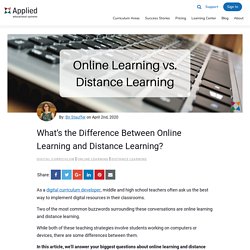
Two of the most common buzzwords surrounding these conversations are online learning and distance learning. While both of these teaching strategies involve students working on computers or devices, there are some differences between them. Triple E Lesson Planning Template - Triple E Framework. Triple E Framework - Home. Best Practices for Using Video in Online Learning - TOPkit.
By Mary Fry. When the Tide Goes Out: Identifying and Supporting Struggling Students in Online Courses. Students in online courses start with the best intentions—keeping up with the readings and assignments, engaging in discussion, and learning from their instructor’s feedback and comments. Once an online course begins, students can quickly become overwhelmed to the point where they are treading water in an attempt to stay afloat. It is only when the first grades are posted that the tide goes out and students realize they are in danger. This is where instructors can easily identify the students who are not succeeding. When the Tide Goes Out: Identifying and Supporting Struggling Students in Online Courses. Synchronous Learning vs. Asynchronous Learning in Online Education. What’s the difference between synchronous learning and asynchronous learning? The answer could have a huge impact on your online education experience. PZ's Thinking Routines Toolbox.
Welcome to Project Zero’s Thinking Routines Toolbox. This toolbox highlights Thinking Routines developed across a number of research projects at PZ. A vast array of PZ's work has explored the development of thinking, the concept of thinking dispositions, and the many ways routines can be used to support student learning and thinking across age groups, disciplines, ideals, competencies, and populations. Thinking Routines originated in PZ’s Visible Thinking research initiative. Seesaw vs. Google Classroom: What's the Best Management App for Your Classroom? The Building Blocks of an Online Lesson. Full-Class Implementation Model. Virtual Learning Leadership Alliance — Digital Learning Collaborative. Combining more than 150 years of online and blended learning operational experience, the Virtual Learning Leadership Alliance is an association of the chiefs of some of the most innovative virtual programs in the US.
Consisting largely of leading state virtual schools, and several outstanding consortia, the member organizations serve well over a quarter of a million online course enrollments annually, provide their districts and students with over 2,200 active, highly-qualified teachers trained in online instruction, supply blended learning services to their constituents, and conduct research to validate the value of online learning.
The Virtual Learning Leadership Alliance (VLLA) is a 501c3 educational nonprofit organization. National Standards for Quality Online Learning. Standard B: Content The online course provides learners with various content options that promote their mastery of content and are aligned with state or national content standards. B1 The online course objectives or competencies are measurable and clearly state what the learner will be able to demonstrate as a result of successfully completing the course.* B2 The online course expectations are consistent with course-level objectives or competencies, are representative of the structure of the course, and are clearly stated.
National Standards for Quality Online Learning. National Standards for Quality Online Learning. ETEC 510: The R2D2 Model of Instructional Design. Theory of Online Learning. This is a new page created by Kerry-Ann Henry, February 2011. The R2D2 Model of Instructional Design. Glossary. 10 Elearning Authoring Tools: Comparison and Review. R2D2 goes to work: the design and development of a first year art. E-learning - elearning model framework distance education blended learning.
OLF 2018 v14 0. ED529699. How states can reimagine teacher preparation to ensure edtech skills. Exploring the R2D2 model for online learning activ. Introducing the R2D2 Model: Online learning for the diverse learners of this world: Distance Education: Vol 27, No 2. How to Make Effective Videos for Learning. Full-Class Implementation Model. Full-Class Implementation Model. Virtual Education Dilemma: Scheduled Classroom Instruction vs. Anytime Learning.
Virtual Learning Leadership Alliance — Digital Learning Collaborative. VSLA TS IL. Virtual Classroom Best Practices for Delivering Training. 12-Step Plan for Effective & Engaging Virtual Training Sessions. Our best remote learning, and why it worked. – Coaching School Change. Moodle. Distance Learning & Virtual Classrooms: Where Learning Never Stops - myViewBoard Blog.